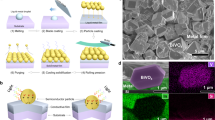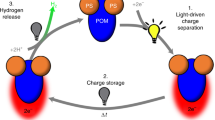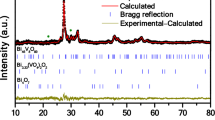Abstract
ATTEMPTS to mimic the highly efficient process of photosynthesis1–3 are of considerable interest, the goal being to design artificial systems for the efficient conversion of solar energy into chemical or electrical energy4–14. In both natural and artificial systems, the underlying process is photoinduced charge separation, typically involving a redox reaction between a photoexcited donor molecule and an acceptor molecule. Through careful choice of the molecular arrangement, and the redox potentials of the donors, intermediate charge carriers and acceptors, it is possible to minimize the reverse electron transfer process and thereby obtain stable photoinduced charge separation. In this context, photochemical electron acceptors based on methylviologen and its derivatives have been widely studied5,6,8–12,14–19. Here we describe the synthesis and characterization of metal biphosphonate multilayer thin films composed of viologen-based acceptor layers and donor layers of p-phenylenediamine. Our method of film growth provides control over both the structure and composition of the multilayer films, leading to efficient photoinduced charge separation and directional electron transport. These films generate photocurrents when irradiated with ultraviolet and visible light.
This is a preview of subscription content, access via your institution
Access options
Subscribe to this journal
Receive 51 print issues and online access
$199.00 per year
only $3.90 per issue
Buy this article
- Purchase on Springer Link
- Instant access to full article PDF
Prices may be subject to local taxes which are calculated during checkout
Similar content being viewed by others
References
Deisenhofer, J. & Norris, J. R. (eds) The Photosynthetic Reaction Center (Academic, San Diego, 1993).
Barker, J. (ed) The Photosystems: Structure, Function and Molecular Biology (Elsevier, New York, 1992).
Michel, H. & Deisenhofer, J. Pure appl. Chem. 60, 953–958 (1988).
Hidalgo-Luangdilok, C. & Bocarsly, A. B. Inorg. Chem. 29, 2894–2900 (1990).
Grätzel, M. Nature 366, 206–207 (1993).
Fujihira, M. in Photophysical Processes in Organized Molecular Systems (ed. Honda, K.) 463–482 (Elsevier, New York, 1991).
Fujihira, M., Kubota, T. & Tetsuo, O. J. Electronanalyt. Chem. 119, 379–387 (1981).
Bard, A. J. & Fox, M. A. Acct. chem. Res. 28, 141–145 (1995).
Brugger, P.-A. & Grätzel, M. J. Am. chem. Soc. 102, 2461–2463 (1980).
Baral, S. & Fendler, J. H. in Photoinduced Electron Transfer Part B (eds Fox, M. A. & Chanon, M.) 541–598 (Elsevier, New York, 1988).
Kalyanasundaram, K. & Grätzel, M. Coord. Chem. Rev. 69, 57–125 (1986).
O'Regan, B. & Grätzel, M. Nature 353, 737–740 (1991).
Rong, D., Yeong, I. K. & Mallouk, T. E. Inorg. Chem. 29, 1531–1535 (1990).
Yao, G.-J., Onikubo, T. & Kaneko, M. Electrochimica Acta 38, 1093–1096 (1993).
Snover, J. L. & Thompson, M. E. J. Am. chem. Soc. 116, 765–766 (1994).
Ungashe, S. B., Wilson, W. L., Katz, H. E., Scheller, G. R. & Putvinski, T. M. J. Am. chem. Soc. 114, 8717–8719 (1992).
Salama, A., Ottolenghi, M. & Avnir, D. Nature 355, 240–242 (1992).
Yonemoto, E. H. et al. J. Am. chem. Soc. 116, 10557–10563 (1994).
Vermeulen, L. A. & Thompson, M. E. Nature 358, 656–658 (1992).
Snover, J. L., Byrd, H., Suponeva, E. P. & Thompson, M. E. Chem. Mater. (submitted).
Yang, H. C. et al. J. Am. chem. Soc. 115, 11855–11862 (1993).
Mallouk, T. E. & Harrison, D. J. in Interfacial Design and Chemical Sensing (eds Mallouk, T. E. & Harrison, D. J.) (ACS Symp. Ser. No. 561, (American Chemical Soc,, Washington DC, 1994).
Cao, G., Hong, H.-G. & Mallouk, T. E. Acct. chem. Res. 25, 420–427 (1992).
Vermeulen, L. A., Snover, J. L., Sapochak, L. S. & Thompson, M. E. J. Am. chem. Soc. 115, 11767–11774 (1993).
Lewis, N. S. & Bocarsly, A. B. in Semiconductor Electrodes (ed. Finklea, H. O.) 80–119 (Elsevier, New York, 1988).
Author information
Authors and Affiliations
Rights and permissions
About this article
Cite this article
Byrd, H., Suponeva, E., Bocarsly, A. et al. Photocurrent generation in metal bisphosphonate multilayer thin films. Nature 380, 610–612 (1996). https://doi.org/10.1038/380610a0
Received:
Accepted:
Issue Date:
DOI: https://doi.org/10.1038/380610a0
This article is cited by
-
Characterization and applications of ion-exchange membranes and selective ion transport through them: a review
Journal of Applied Electrochemistry (2023)
-
Synthesis, Crystal Structure, Photophysical Properties, and DFT Calculations of a Bis(tetrathia-calix[4]arene) Tetracadmium Complex
Journal of Cluster Science (2010)
Comments
By submitting a comment you agree to abide by our Terms and Community Guidelines. If you find something abusive or that does not comply with our terms or guidelines please flag it as inappropriate.



